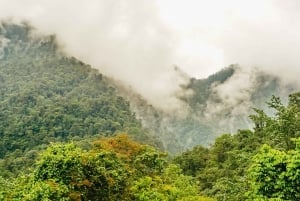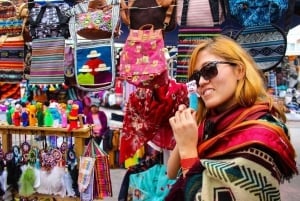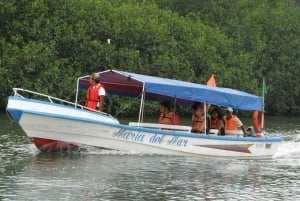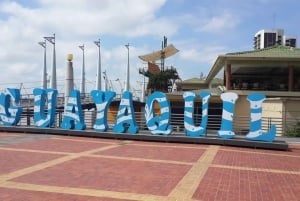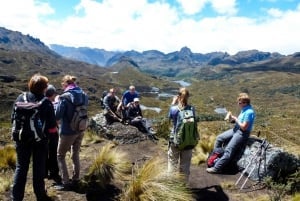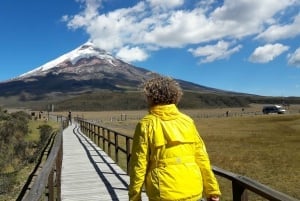Transportation
Ecuador is a small country, the size of the United Kingdom or the State of Colorado in the United States. Hence, moving around is quite easy, it generally implies short times rather than long trips and there are many alternatives to choose from. The country’s main cities have ample taxi, bus and other public transportation systems to mobilize within the cities. In smaller towns, particularly in the Coastal and Amazonian lowlands, there are ingenious local transportation means such as specially adapted bikes or tricycles which can be a fun and different experience for short in-town rides.
There is a wide network of buses for transportation between cities, ranging from short-haul or “vicinity” buses to longer distances for which several cooperatives, many of them established for decades, offer an abundant selection of day and night frequencies between dozens of destinations. The larger cities have one or more, some of them very modern, Inter-City Bus Stations. Some companies have private Terminals at designated locations in the cities or towns.
On all public transport systems, like most everywhere in the world, caution ought to be used with personal belongings and valuables such as wallets, money, personal documents, smartphones or other flashy electronic gadgets or jewelry. Even though crime and theft are relatively minor as compared with other cities, pick-pockets usually like to stalk on public buses’ riders. These recommendations are valid for all cities in Ecuador.
CITY BUS SERVICES
QUITO
Quito has a Rapid Bus System, which runs across most of the city in three parallel lines in a north-south direction using electricity-powered Trolley-buses or non-contaminating engine systems on dedicated lanes: The Trolebus (central, green line), the Ecovia (east, red line), and the Metrobus (west, blue line –Sur Occidental and Central Norte-); the Sur Oriental (orange line) is an extension of the Ecovia. These buses normally consist of a two-car convoy with seats and ample space for on-foot riders. The Stations are well identified and have ramp facilities for disabled passengers. The cost is $0.25, regardless of the length of the ride. “Feeder” buses connect with the Integrated Rapid System and serve specific routes and neighborhoods located a distance away from the main lines. Additional buses, not part of the Integrated System, serve periphery neighborhoods. These last ones are not recommended for tourists as they may take routes and sectors without much surveillance.
The Trolebus is the transportation means to most of the tourist sights; it goes through almost the whole length of the city, starting at the northern station of “La Y”, along Diez de Agosto Avenue, passing a few blocks away from La Carolina park and the financial-commercial district, by El Ejido park, entering the Old Downtown, and passing by Chimbacalle Train Station, finally ending at Quitumbe Station, the southern hub for inter-city and inter-province buses. If you want to go to El Panecillo, the best way is to take a taxi or a tour. To go by bus to the Center of the World monument (Mitad del Mundo), you will get to the Metrobus station of “La Ofelia” and from there take a feeder bus to Mitad del Mundo.
For more detailed information, like operation schedules and maps, click here.
Quito has started the construction of a super-modern Metro or Underground System due to cross most of the length of the city (which is naturally long and narrow) in some twenty minutes. The service is planned to be inaugurated in 2016.
GUAYAQUIL
The nation’s largest city and main seaport also offers the “Metrovia”, a modern Integrated Rapid System, quite similar to Quito’s, crossing much of the city’s length in north-south direction, and a system of “feeder” buses serving other neighborhoods to connect with the main line. Additional bus lines, equally not recommended for tourists, serve the wide complex of city neighborhoods and periphery districts.
For more detailed information, like operation schedules and maps, click here.
CUENCA, Ecuador’s third most important and populated city will inaugurate a modern Tram System, meant also for massive public transportation, with international standards of safety, comfort and speed. As elsewhere, a host of bus lines serve the city’s neighborhoods, districts and vicinity towns.
Cuenca’s bus terminal is located only a few blocks from the airport.
CITY TAXI SERVICES
Quito, Guayaquil, Cuenca, Manta (central Pacific coast) and all larger cities and provincial capitals offer local taxi services. Taxis are usually inexpensive as compared to international standards and most of them bear the traditional yellow color. Formal cooperatives and legal taxis have identification plates on the front doors and inside, in the back of the front seats. Most of them have radio communication services and can be called from hotels, restaurants or private homes. A legal service of “Executive Taxis” (not always yellow), duly supervised and controlled by the Transit and Transportation authorities, is available in the main cities. These mostly work on an exclusive, door-to-door, on-call phone service basis. For safety reasons travelers are not advised to hail a taxi off the street at night. It is much better to ask the hotel, restaurant or nearest secure location to call a radio-taxi for you. All legal taxis have and must use meters and the minimum, short-range rate costs one dollar. An average ride from Quito’s north-central financial and business district (where a large number of the hotels are located) to the city’s Historic Center may cost between 4 and 5 US dollars, one way. In some cases, night surcharges may apply, but it varies widely between cities and types of taxi services. While meters are compulsory, their actual use by the cabbie-drivers is not that regular. An important recommendation for taxi users is to verify before starting the ride if the meter will be used and if not, to agree on a pre-settled fixed rate, depending on the desired destination and hour of the day. Tipping taxi drivers is not customary and not expected. You may tip them in case you have received extraordinary services and attention. Another tip to keep in mind is that, particularly in Quito and Guayaquil, finding taxis at rush hours can be a difficult task. Peak hours in Quito are from 7 to 9 am, 12 to 2 pm and 5 to 7:30 pm.
INTER-CITY AND INTER-PROVINCE BUS SERVICES
As mentioned before, there is a wide network, nation-wide, of Inter-City Bus services. These range from little-comfort and no-fills simple buses to modern, international-class buses with reclining seats, in-bus toilets, television, public speaker systems and hosts or hostesses serving meals, soft beverages and/or snacks. All of them, regardless of class, are regulated, revised and controlled by the National Transit and Transportation authorities, for safety of vehicles and compliance with licenses and regulations by the drivers and buses themselves.
Quito, Guayaquil, Cuenca, Manta and the larger cities and provincial capitals have special Bus Terminals, and the majority offer 24-hour services and hourly departures, especially between the cities with the greater local demand as well as popular tourism destinations.
Quito, due to its geographic length has two Bus Terminals: Terminal Quitumbe, in the southern part of the city, and Terminal Carcelén, in the northern part of the city. In general terms, Carcelén serves the routes to the north of the country, like Otavalo, Ibarra, Esmeraldas and all the way to the border with Colombia, while Quitumbe Terminal serves the routes to the south, including Cotopaxi, Baños, Cuenca and Guayaquil; but this is not a rule, for example Trans Esmeraldas only departs from Quitumbe and from its own agencies; you’ll have to find out with each company about their specific departure points (see some useful links below for contact info). Quitumbe is the most southern station of the three rapid transit lines so you get there taking any of those lines; Carcelén Terminal is somewhat far off, about an hour away by bus from La Mariscal, but has feeder buses to and from the rapid transit system stations. Unfortunately, Quito’s bus terminals don’t have websites with information on bus routes or schedules, any information has to be obtained directly through the bus companies.
Guayaquil has a very modern Bus station, known by everyone as the Terminal Terrestre located a short distance from the city’s International Airport. It includes ample parking, shopping areas and a food court. Their website (www.ttg.ec) has schedules and fares for all the bus companies, by destination. Some of the better-faring bus companies have private Depots or Stations at specific locations within the cities, mainly in Quito and Guayaquil.
Fares are quite low for international standards and vary according to the distance, destinations and class of service. Schedules can be found by calling the bus companies or checking their websites (not all of them have them or provide fully reliable, updated websites), see some useful links below. There are no known on-line ticket purchasing services currently available. For instant or advanced purchasing of tickets, travelers must go to the company’s offices in the Bus Terminals or elsewhere. You can always buy tickets at the time and point of departure; if it’s not a busy time, like a holiday, there usually is enough space.
As a matter of examples, some of the country’s main Inter-City Bus Companies are: Transportes Ecuador, Panamericana, Flota Baños, Flota Imbabura and Trans Esmeraldas. There are dozens of other companies covering a national network of routes or restricted to regional services or even “vicinity” and short-haul routes. A safety tip for foreign travelers is to take preferably daytime frequencies better than overnight frequencies. Infrequent road-robberies on night buses are occasionally reported.
TRAIN SYSTEM
The train in Ecuador is mostly used for touristic purposes. Tren Ecuador is the company that manages the whole system and offers several interesting routes within the country. You can see more detailed information on their website as well, including departure schedules, and can reserve and buy tickets by phone. Reservations are recommended, as some routes, like the famous Devil’s Nose, are quite busy. They have an efficient customer service and the train stations are well appointed with clean bathrooms, most have a coffee shop, and some have a souvenir and handicraft shop. All routes include bilingual (Spanish-English) guidance. Tren Ecuador also offers luxury tours on their Cruise Train.
CAR RENTALS
The main cities like Quito, Guayaquil, Cuenca and Manta, plus most of the provincial capitals and other important cities, offer Car Rental services. As usual, the main offices are generally located in or near the main Airports; but other offices can be found at specific and strategic locations like near the bus terminals. Internationally recognized brands, operating under the system of franchises, offer reliable services, good vehicles and can cater for the specific needs of travelers. Payment can be made with international credit cards. They can be good sources to acquire updated road maps and detailed information about road travel in Ecuador. Prices are generally considered as slightly below the average for other countries in the region. Travelers renting cars should be cautioned that away from the main roads, the signaling can be poor, misleading or non-existent.
NATIONAL ROAD SYSTEM
In the last five years Ecuador has improved substantially the quality of its roads network and is being referred to as one of the best and most modern road networks in Latin America. Currently, much of the country offers the travelers international-class highways and motorways, paved or of concrete, boasting vertical, horizontal and reflective signaling for night travel or foggy weather conditions. Of course, there still are more remote areas with second-class roads and poor or non-existent signaling. The majority of the main tourism destinations, with the odd exception, do have good road accessibility and signals. The country’s most important road is the legendary Pan American Highway, the E-35 Route, which acts as the backbone of the National Road System and traverses the full length of Ecuador, from the Colombian border in the north to the Peruvian border in the south, through the center of the two main Andean Ranges, with several lateral branches serving some important cities and tourism enclaves, east, towards the Amazon Region and west towards, Guayaquil, Manta, Esmeraldas, and the Pacific lowlands and beaches.
Other important roads are the E-15 Coastal Road, which follows the “Sunshine Route” near or along the over 900 miles of beaches along the Pacific coast, also in a north-south direction. Similarly, the Trans Amazonian Road or E-45, crosses this part of Ecuador equally with a north-south direction. The Inter-Oceanic Road, meant to unite one day the Pacific with the Atlantic, across Ecuador, Peru and Brazil, currently offers a first-class option for travel between Quito and destinations on the Eastern Andes and Amazon Region, in a west-east direction. The majority of the main roads have Toll Plazas at strategic locations. It is advisable to carry coins to pay the tolls (normally not exceeding one dollar).
USEFUL LINKS:
PUBLIC TRANSPORTATION
Metrobus-Q Quito – trolebus.gob.ec
Metrovia Guayaquil - metrovia-gye.com.ec
Cuenca: cuenca.gov.ec
TAXI SERVICES
See our Important Places and Numbers section.
AIRPORTS
See our International Airports section.
BUS TERMINALS
Terminal Terrestre Guayaquil - ttg.ec
BUS COMPANIES
Trans Esmeraldas: transportesesmeraldas.com
Cooperativa de Transportes y Turismo Baños: http://cooperativabanos.com
Cooperativa de Transportes Loja: cooperativaloja.com
Panamericana: panamericana.ec
Super Semería (Cuenca –base-, Guayaquil, Perú): http://semeriaecuador.com
Cuenca Inter-province Bus Companies: cuenca.com.ec/cuencanew/node/52
TRAIN
Train Company (Tren Ecuador) - /things-to-do/tren-ecuador, http://trenecuador.com/en/trainecuador
CAR RENTAL COMPANIES
ONLINE TICKET PURCHASE











